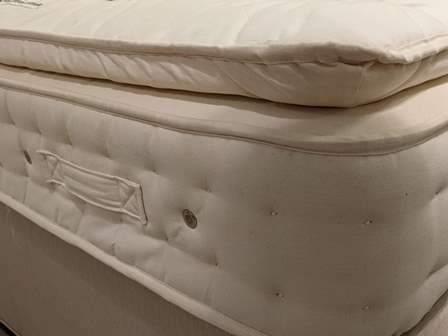Definitions vary a bit, but the best natural mattress is one that uses things like cotton, wool, latex and springs. Natural mattresses are usually more expensive than manmade mattresses as the materials are pricier.
Some natural mattresses also use fancy materials like cashmere. However, this can be a bit of a sales gimmick as the actual amount used in each mattress may be small.
You’ll find that most mattresses described as ‘natural’ also contain a small amount of manmade materials such as polyester. However, these are usually buried deep down so you still get the benefits of the more breathable and posher natural materials.
The environmental impact of the best natural mattresses
It’s also worth considering the research into the impact of mattresses on the environment.
This topic was studied by Glew, Stringer et al in 2012. They found that
‘Natural fibre (biomaterial) pocket spring mattresses are shown to emit marginally less greenhouse gasses than foam (petrochemical) pocket spring mattresses.’
That would appear to be an endorsement for pocket sprung mattresses which use layers of wool, cotton, coir and latex rather than memory foam mattresses.
However, the researchers then go on to say that the impact once you’ve finished with the mattress has the potential to be much bigger (‘when end of life scenarios are considered, the results suggest much larger GHG emission reductions for natural fibre than foam mattresses. Refurbishing natural fibre mattresses and reusing the springs, coupled with recycling the waste components, can reduce GHG emissions by 90% compared to sending the mattresses to landfill’.)
On the other hand, a foam mattress such as the Nectar Sleep mattress has ‘climate neutral manufacturing’ and ‘environmentally friendly materials’. That’s according to the sustainability section of their website.
Are the best natural mattresses good or bad for allergies?
There is an argument that people who suffer from allergies to dust mites are better to avoid natural mattresses. According to Mattress Online, “Foam mattresses are particularly beneficial in lowering the risk of dust mites and allergens in your bedroom.”
However, that’s contrary to a notable study by academics in Norway. They took samples from both foam and sprung mattresses and concluded that ‘A simple replacement of foam mattresses with spring mattresses may reduce the exposure to house-dust-mite allergens’. (‘House-dust mites and mattresses’ Schei, Hessen et al, 2002).
Our selection of the best natural mattresses
We’ve picked out five of the best natural mattresses and chemical free mattresses. We looked at factors such as brand reputation, customer reviews, specification and value for money.
Prices are correct at the time of writing and are for double mattresses. Review scores are correct at the time of writing.
1. Millbrook Wool Luxury 4000 Pocket Natural Mattress – £603 (medium/firm)
Southampton-based Millbrook Beds make a range of wool mattresses, which come with a rather appealing 60 night trial period (read the Ts and Cs). If it’s not comfortable, you can swap it for another mattress. Trial periods are common in the memory foam market, but less so in mattresses made from natural materials.
It also has a 10 year guarantee. That’s really good for a natural bed of this price.
The Millbrook brand won a big award in 2018/2019 when it was named as Bed Manufacturer of the Year.
We’ve gone for the Millbrook Wool Luxury 4000 Pocket Natural Mattress although there are cheaper models in the range.
Two layers of springs
As with most natural mattresses, it uses pocket springs which are the superior type of spring in a mattress. Some cheap mattresses use open coil springs which are far less stable and supportive.
The 4000 number in the title refers to the number of springs. Normally, this means that a mattress has a layer of big springs to support you and a layer of small springs for extra comfort. However, this mattress has actually got two layers of full size pocket springs. That should mean it will provide plenty of support.
An impressive list of natural materials
Besides the springs, it also has ‘temperature regulating cotton, absorbent flax, locally sourced Hampshire Wool, moisture controlling silk, luxurious cashgora, super soft bamboo and sumptuous pashmina’. Cashgora is a type of goat which is a cross between cashmere and angora. Every day’s a school day, eh?
Other signs of quality in this mattress are the hand-side-stitching. That means it’s made in a labour-intensive way so that the sides won’t collapse when you sit on the edge of the bed to put your socks on.
The cover is made from Egyptian cotton which is better and more expensive than standard cotton. That’s because it’s made from longer strands which are better for bedding.
A double-sided design
This mattress is also very deep at 28cm. That’s not a guarantee of quality but it’s a good sign. You can turn it over, which is seen as a good thing because it can help a mattress last longer. Single sided mattresses are common but there’s a risk you’ll end up with a big dent of your bottom after a few weeks.
Customer reviews are currently more than 4.7/5.
Available sizes for this natural mattress include single, double, king size and super king. You can also get some more unusual sizes such as a zip link natural mattress which is similar to two singles side by side.
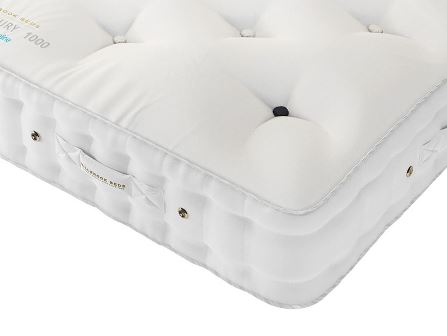
[affcoups id=”4330″]
2. Simba Earth Source Mattress – medium/firm – £1499
Long time readers of this website will be spluttering into their herbal teas at the sight of Simba in our guide to natural mattresses (Ed: trust me, this site doesn’t have long time readers).
About a decade ago, Simba’s thing was all about using cleverly designed (manmade) foam to make excellent mattresses. They came up with one mattress which they felt was perfect for most people. They backed it up with a trial period, whereas long established mattress companies made you drive to an industrial estate, try it out for 30 seconds and then hope for the best.
Simba still sells those highly-rated ‘hybrid’ mattresses which combine memory foam with springs (we have one and like it a lot). However, Simba has now delved into the natural mattress market with its Earth mattresses.
This is something of a full circle for Simba Sleep, and acknowledges that lots of us actually prefer to take advantage of the natural qualities of wool, flax and other materials. There’s also a good argument that this Earth range from Simba is easier to recycle than its foam range.
The really appealing thing is that still get Simba’s generous home trial period. You can try it out for 200 nights (more than six months) and if you don’t like it, they’ll collect it and give you a refund. Simba has tweaked its trial period and at times it has been 100 nights and 365 nights. Two hundred nights as it allows you to try it in summer and winter, so you can really test out the temperature regulating qualities.
Which natural materials does the Simba Earth Source use?
The first two layers in the Simba Earth Source Mattress use wool, whilst the next layers use hemp and flax from Yorkshire. Both hemp and flax are good at moderating temperature, as is wool.
Beneath all that, you’ll find a layer of mini springs, which are similar to those used in Simba’s hybrid mattresses. These “Aerocoil” springs are miniscule but they provide some additional comfort.
This mattress is single sided, which is not my ideal design choice. However, I can see why they’ve done it. There are so many layers pack into the 25cm depth. If you wanted to replicate that on the other side of the mattress, you would end up with a huge mattress and with aa huge price tag.
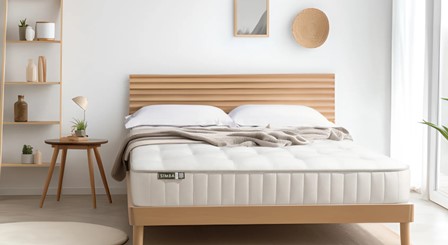
What about Simba’s other natural mattresses?
There are other natural mattresses offered by Simba, including the mid-priced Simba Earth Escape Mattress and the top-of-the-range Simba Earth Apex Mattress. For the extra money you get extra layers of mini springs and posher materials such as a cashmere and mohair, which both come from goats.
These are worthy upgrades, but I personally think that the changes are fairly modest so would probably stick with the Source model unless you have deep pockets.
[affcoups id=”7558″]
3. Herdy Sleep Wool Natural Mattress – medium/firm – £999
The Herdy Sleep mattress isn’t the cheapest but it’s a natural mattress which is worth considering for several reasons.
The vast majority of it is made from natural materials. The top layer is wool, cotton and cashmere. They’re all breathable and good at regulating your temperature.
Each mattress uses ‘one full Herdwick fleece’. Herdwick is a sheep with curly horns which live in the Lake District, so you’re supporting a local traditional trade.
There’s also a thin layer of ‘recyclable polyester’ at the bottom of the mattress. Polyester is a non-natural material.
Trial period and a long guarantee
You get a 100 night home trial period, which is unusual for a pocket sprung mattress. If you don’t like it, they’ll pick it up and give you a refund. As well as the home trial period, there’s also an option to try it out in a store.
It’s got a 10 year guarantee, which is very good for a pocket sprung mattress. 10 years or longer is very common with memory foam mattresses but pocket sprung mattresses tend to come with less generous warranties.
Herdy Sleep is made by a posh mattress company called Harrison Spinks. They’ve won multiple awards and something called a Manufacturing Guild Mark. Only a handful of mattress brands have that award. The brand also starred in an episode of the BBC’s Inside The Factory, which was about as exciting as Line Of Duty for mattress enthusiasts.
This model has also won awards from the likes of The Independent.

[affcoups id=”4266″]
4. Hypnos Luxury Wool No 1 or No 2 Pocket Sprung Mattresses – £1149/£1549 (medium/firm or medium)
You’ve probably heard of Hypnos, which is one of the posher brands in the UK. Its reputation has been helped along with a Royal Warrant. That means Hypnos mattresses are used in a Royal household.
These two models – Hypnos Luxury Wool No 1 and Hypnos Luxury Wool No 2 – are similar but the No 1 is medium/firm tension whilst the No 2 model is medium tension. The more expensive model also comes with an extra layer of wool, which bumps up the price.
Choosing the right firmness on the best natural mattress
As an aside…picking the right firmness for a mattress is quite tricky online. However, the general rules are that larger and heavier people need firmer mattresses than smaller and lighter people. If you’re very light, then you probably won’t sink into a firm mattress very much, so you won’t get much support for your body.
Another general rule is that people who sleep on their backs and fronts need firmer mattresses than those of us who mostly sleep on our sides. The theory is that you put pressure on your hips and shoulders if you sleep on your side. That means that a very firm mattress probably won’t be right for you.
Anyway, back to these two natural mattresses from Hypnos.
How natural is your ‘natural’ mattress?
It’s worth realising that these are not 100% natural mattresses. They both have a layer which is a ‘recycled fibre comfort pad’
However, they also both use lots of wool which is naturally good at regulating your temperature. Both score well with customers.
You get a decent 10 year guarantee and they are designed so that they are strong right to the edges. Hypnos also deserve some praise as they have ‘been carbon-neutral for over a decade’.
On the downside, you can’t turn these mattresses over and you don’t get a home trial period.
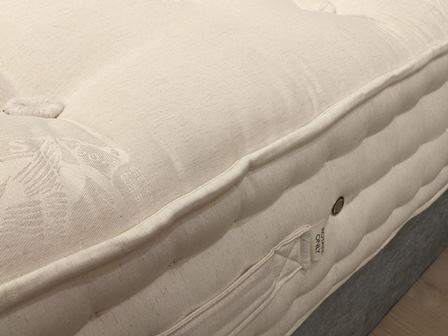
[affcoups id=”3520″]
[affcoups id=”3312″]
5. John Lewis & Partners Natural Collection Egyptian Cotton 5750 Natural Mattress – £1199 (medium or firm)
Apologies, this is another fairly pricey mattress. You do tend to pay a premium price for natural materials rather than synthetic materials.
This one is part of the John Lewis & Partners Natural Collection. It’s certainly not the most expensive mattress in the range but it’s a good compromise of quality and price.
The range is made by a Yorkshire based mattress manufacturer called Harrison Spinks (also mentioned earlier). They’ve won at the National Bed Federation awards in recent years.
The layers on this mattress are not all 100% natural, but the vast majority of it is. It uses wool, cotton and flax as well as a synthetic ‘fibre pad’ on the bottom layer. It’s also got a ‘completely glue-free design’ which they say makes it easier to recycle.
A very high spring count
The 5900 number refers to the number of springs it uses. If you’re really interested in the technical stuff then it’s worth noting that it actually uses two layers of springs.
Some are full size springs (for support) and some are mini springs (for comfort). Perhaps more important than the number of springs is the fact that the larger springs in this mattress won an award in 2019. Yes, there really is an award for the design of springs.
One big plus is that you can choose from medium or firm tensions. John Lewis suggest that the medium version is ‘Suitable for bodyweights of 8-16 stone (50kg-100kg)’. The firm version is ‘Optimum comfort for bodyweights over 16 stone (100kg+)’.
It comes with a seven year guarantee which is good but not spectacular for this price tag. Other downsides include the fact that it’s only one sided, so you can’t flip it over to make it last longer. Double sided mattresses in the John Lewis Natural Collection are even pricier.
A trial period, with a few caveats
There is also a 60 night home trial period with this mattress. For a long time that wasn’t the case as it was only introduced in 2021.
It isn’t quite as straightforward as some mattress trials because you have to a) buy a mattress protector at the time of purchase b) pay to return it and c) swap it for another model.
However, it’s a welcome add-on which adds another option for online shoppers. Many people don’t fancy spending hundreds of pounds on something which may not suit them.
Value for money?
You may ask why you should spend somewhere around £1000 for a John Lewis & Partners mattress when other models from the same retailer are much cheaper. The most obvious feature is a higher spring count. However, there are other factors which are important but less visible such as hand-side-stitching.
We analysed 48 mattresses sold under the John Lewis & Partners own brand. Some were from their posher range and others were from the budget options.
Nine mattresses were those which cost under £500 for a double mattress. The rest cost between £500 and £9800.
The bar chart below shows that ‘hand side stitching’ is much more common on the more expensive mattresses than the cheaper ones. This is unsurprising, considering the extra manufacturing cost of the process which involves strengthening the side of the mattress with a number of stitches which are done by hand.
The advantage for the user is that you get a mattress which is stronger when you sit down to put your socks on. It also helps it maintain its overall shape over the years.

[affcoups id=”4332″]
6. Dunlopillo Royal Sovereign Natural Latex Mattress – (medium/firm) – £2099
A Dunlopillo mattress is a great option for a natural mattress. Unfortunately, you’ll need deep pockets.
Is latex what you need for the best natural mattress?
They’re made from latex, which is a natural material which comes from rubber trees. It naturally ‘responds to your weight and shape to provide pressure relief tailored to you’ (according to Mattress Online). Plus, it can be produced sustainably.
So, why aren’t all mattresses made from latex?
One answer is that it’s very expensive to produce. Most ‘latex’ mattresses just use a 2-3cm layer of latex on top of synthetic materials. Meanwhile, Dunlopillo use about 10cm of latex in their mattresses. They’re the brand leaders in the latex mattress market.
You get an eight year guarantee, which is OK but not remarkable for a mattress of this price.
The mattress we’ve picked out is the Royal Sovereign which is medium firmness.
On TrustPilot, Dunlopillo is one of the highest rated brands with customers. It scores an average of 4.7/5
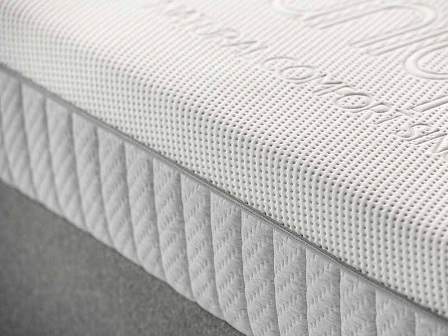
[affcoups id=”3874″]
